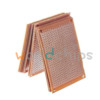Already having chosen to go with perforated style boards, there are really only about 3 (one comes in both of the other 2 styles) types to choose from. Any product I am aware of as far as brands and material should not have any problem meeting you needs. They will all give no care to normal temps and are pretty easy to cut. Straight lines can be scored with a razor then broken, and odd shapes are easily cut with a hack saw, or Dermel type cutting wheel.
There are 3 basic sorts of boards I am aware of:
.1 inch spaced holes on plain board.
.1 inch spaced holes on board with a copper dot on each hole.
The last comes in both of the other sorts and is a board with holes drilled to match a prototyping breadboard. You can set the perf board over the bread board, then once you have your circuit working, tape all the components down, separate the perf from bread board, flip it over and solder along the lines. These are really nice if you're just getting started with "complex" circuits, but are otherwise not worth much more discussion here.
As for copper dots or no copper dots, I've used a lot of each. No dots is cheaper, but dots make soldering easier and cleaner. If you are pretty handy with a soldering iron, the dots are not really needed.
As a last bit of advice, if you are using any IC's I recommend soldering in sockets rather than soldering directly to the part. Here especially, the copper dots are helpful, with the short legs on DIP parts.
Edit: as a note, almost all parts that would be used in hobby electronics will have leads with standard .1 inch spacing. some odd parts like trimmer pots may need an off hole drilled here or there, and any small drill bit works fine on the boards I've seen.
Edit #2: also be ware with bending the leads. round, wire type leads on resistors and diodes are pretty forgiving, but the square ones on LED's and transistors don't like to be bent more than once.








